For artisan soapmaking, you'll find silicone, wooden, and metal molds offer the best results. Silicone molds provide flexibility and easy release for intricate designs, while wooden molds deliver excellent insulation for cold process soaps and add rustic charm. Metal molds guarantee durability and superior heat retention for consistent, professional-quality bars. Your choice depends on your specific needs: batch size, design complexity, and production volume. Understanding each material's unique properties will help elevate your soap crafting journey.
Understanding Different Soap Mold Materials
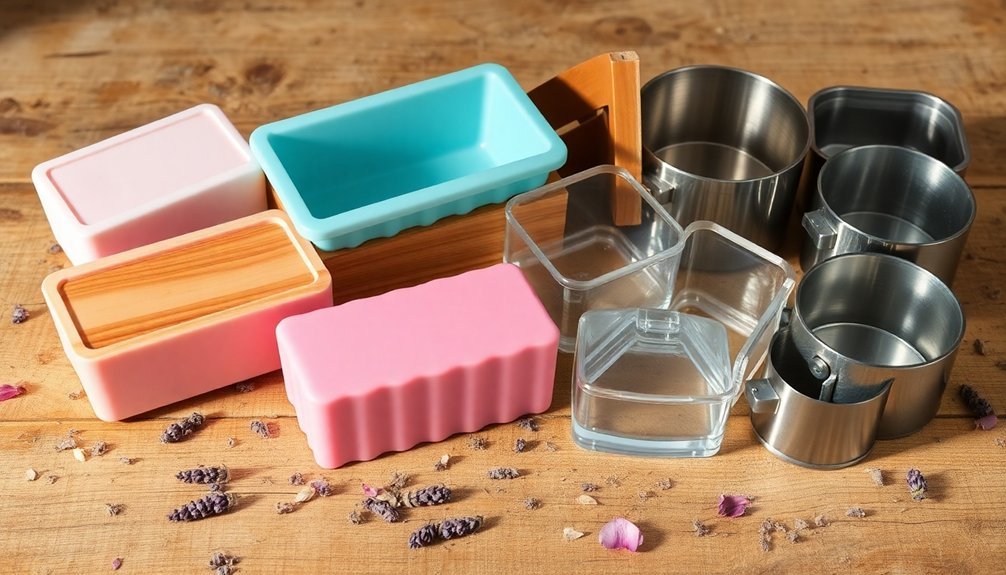
When choosing soap molds for your artisan creations, understanding the different materials available will greatly impact your final product.
Wooden soap molds, typically made from non-treated pine, work well for larger batches but require lining with grease-proof paper.
Pine wooden molds handle large soap batches beautifully, though you'll need to line them with grease-proof paper before use.
You'll find silicone molds are perfect for smaller projects, offering easy release and versatile shapes without needing any liner.
While plastic soap molds come in various designs and are budget-friendly, they can flex during unmolding.
Metal molds provide the most durability but require proper maintenance to prevent rust.
If you're looking for unique shapes, custom molds made from HDPE, PVC, or acrylic let you create distinctive designs.
Each material has its advantages, so selecting the best soap molds depends on your specific needs, batch size, and design preferences.
Silicone Molds: Benefits and Applications
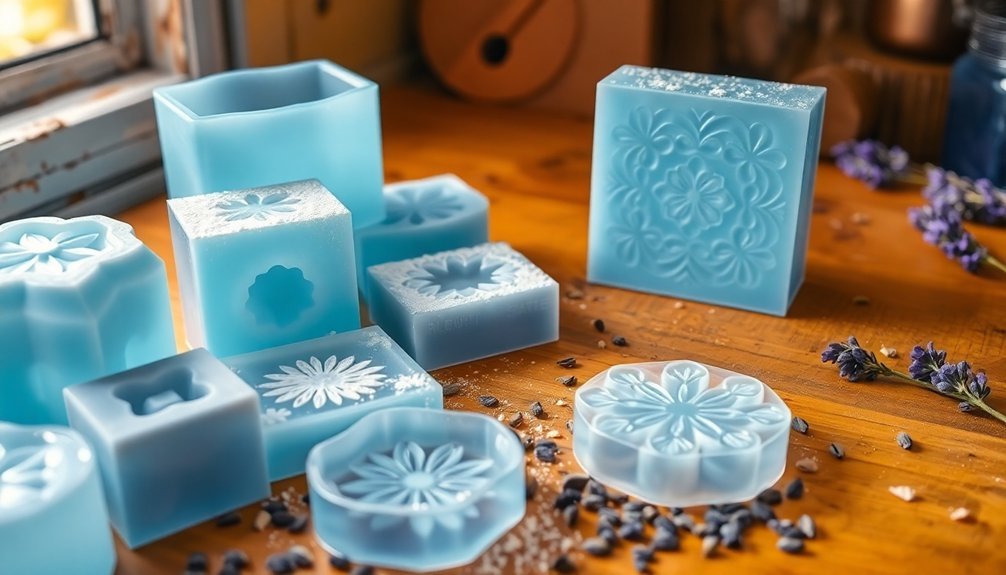
Among all mold materials, silicone stands out as a top choice for artisan soapmakers. You'll find these non-toxic molds perfect for both cold process soap and melt-and-pour techniques, as they can withstand temperatures from -40°F to 446°F.
Their flexible nature makes unmolding a breeze, protecting your intricate designs from damage during removal.
When you're creating artisan soap, you'll appreciate that silicone molds don't need additional lining and come in various creative shapes, from hearts to flowers.
They're also incredibly easy to clean – just pop them in the dishwasher, and they won't retain scents or colors from previous batches.
This means you can switch between different soap recipes without worrying about cross-contamination, making silicone molds a practical investment for your soapmaking journey.
Metal Molds for Professional Results
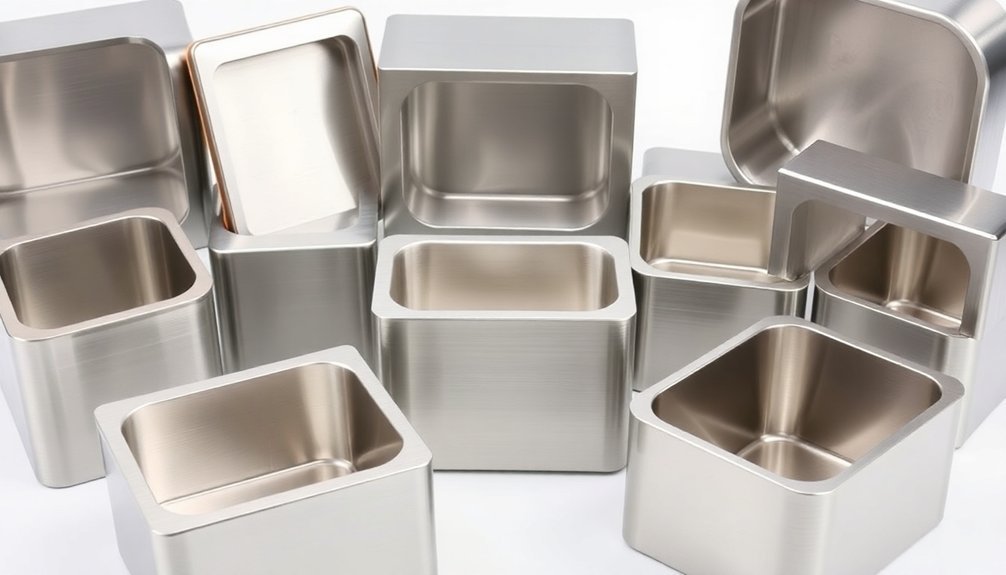
Professional soapmakers often gravitate toward metal molds because they deliver superior results and exceptional durability. When you're investing in metal molds, you'll benefit from their excellent heat retention and ability to create sharp, clean edges that give your soaps a professional finish.
Here's why metal molds are worth the investment:
- They're virtually warp-proof, ensuring consistent results batch after batch.
- Their superior heat retention promotes ideal saponification.
- You'll get precise, clean-edged bars that enhance presentation.
- They feature non-stick coating or can be lined for easy soap removal.
While metal molds may cost more upfront, they're a smart choice if you're committed to high-quality soap production.
Their durability and performance make them indispensable tools for professional soapmakers who won't compromise on quality or consistency.
Wooden Molds: Traditional Craftsmanship
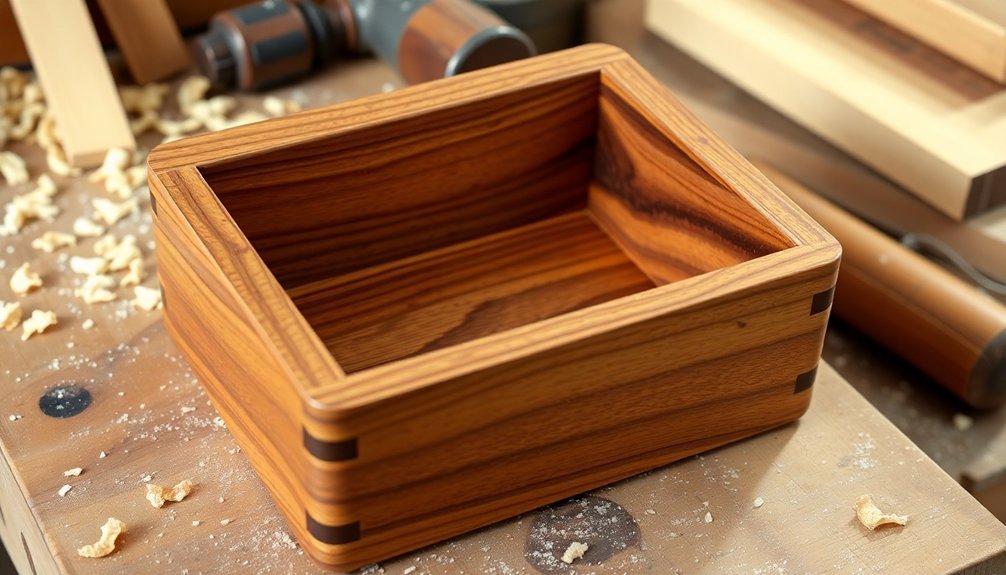
Although metal molds offer precision, wooden molds bring a cherished traditional element to artisanal soapmaking.
You'll find that wood molds, typically crafted from non-treated pine, excel at insulating cold process soap, which speeds up saponification and improves texture. They're perfect for both hobbyists and professionals, offering customizable sizes and designs.
When you're using wooden molds, don't forget to line them with grease-proof paper – it's vital for easy removal of soap once it's set. These molds add a rustic charm to your handmade products, enhancing their artisanal appeal.
To guarantee longevity, proper care is essential. Clean your molds thoroughly after each use to prevent residue buildup and potential contamination from lye or soap. With proper maintenance, they'll serve your soapmaking endeavors for years to come.
Making DIY Soap Molds at Home
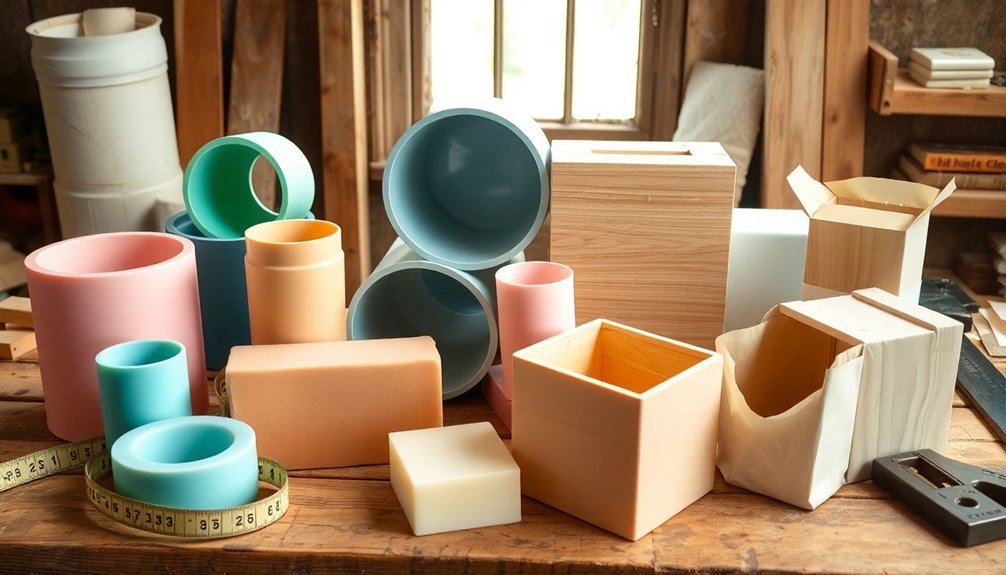
While wooden molds offer traditional charm, you can start making soap without investing in specialized equipment.
Creating DIY soap molds from everyday items is both cost-effective and easy to use. Transform cardboard boxes, ice cube trays, and food containers into functional molds by properly lining them with silicone or parchment paper.
When crafting your DIY soap molds, follow these essential steps:
- Choose non-reactive materials that won't interact with lye or soap ingredients
- Line your containers with plastic wrap, wax paper, or silicone for easy release
- Test the durability of your chosen container to verify it'll hold up during the process
- Create adequate lining overlaps to remove the soap smoothly once it's hardened
These simple techniques let you explore soapmaking without the expense of specialized silicone molds.
Essential Features of Quality Soap Molds
Three fundamental features define a quality soap mold: durability, material compatibility, and ease of use. When selecting quality soap molds, you'll want to focus on durable materials that can withstand repeated use and temperature changes.
Silicone molds offer exceptional versatility, allowing for intricate designs while ensuring easy release of your finished soaps. Your mold's proper size should match your production needs, whether you're making small batches or larger quantities.
Look for molds with smooth edges and surfaces that won't compromise your soap's appearance. The material should also complement your chosen soap-making technique – silicone works well for both cold and hot process methods, while wooden molds excel at insulation for cold process soaps.
Caring for Your Soap Making Molds
Maintaining your soap molds properly will greatly extend their lifespan and guarantee consistent, high-quality results. To maintain mold quality, you'll need to clean soap molds thoroughly with warm water and dish soap after each use. Silicone molds are dishwasher-safe, while wooden molds require careful hand cleaning to prevent damage.
Ensure successful long-term use of your molds by following these essential steps:
- Remove all soap residue using white vinegar for stubborn spots.
- Dry molds completely before storage to prevent mold growth.
- Line wooden molds with grease-proof paper for easier soap removal process.
- Inspect regularly for wear and tear, especially in plastic molds.
Remember that proper care between uses is just as important as the soap-making process itself, ensuring your molds remain in top condition for years to come.
Advanced Techniques for Complex Mold Designs
When you're ready to master complex soap designs, you'll need to understand how different mold materials work together for multi-layer construction, with silicone and acrylic being particularly effective for achieving intricate patterns.
Your success with embedded designs depends on maintaining precise temperature control while positioning elements within temperature-resistant molds that won't warp or leak.
Custom inserts can transform ordinary molds into specialized tools for creating unique patterns, especially when you combine them with strategic cavity placement and proper lining techniques.
Multi-Layer Mold Construction
Creating intricate soap designs demands mastery of multi-layer mold construction, where careful attention to both materials and technique plays an essential role.
You'll find silicone molds are ideal for crafting complex designs, as they offer the flexibility needed to remove delicate layers without damage.
To achieve stunning results with multi-layer molds, follow these key steps:
- Select molds with built-in dividers to maintain distinct color and scent combinations.
- Pour each layer at the perfect temperature to guarantee proper bonding.
- Implement the gelling technique by warming the mold in an oven.
- Experiment with different pouring angles to create unique patterns.
These advanced pouring techniques, combined with quality silicone molds, will help you produce professional-looking soaps with striking visual appeal and perfectly blended layers.
Embedded Design Techniques
Through the art of embedded design techniques, you'll discover endless possibilities for creating stunning soap masterpieces that captivate with their depth and complexity.
Using silicone molds is essential for executing intricate patterns successfully, as their flexibility guarantees easy removal without damaging your delicate designs.
To achieve professional results, you'll want to work with transparent soap bases that showcase your embedded designs beautifully.
When pouring your soap, maintain precise temperature control to prevent embedded elements from sinking or distorting.
You can experiment with various pouring techniques, from swirl patterns to layered effects, creating unique visual compositions within each bar.
Try incorporating small embedded objects like dried flowers or herbs, or create separate mini-molds for custom embeds that you can arrange precisely within your main design.
Custom Insert Placement
The art of custom insert placement opens up three essential avenues for creating complex soap designs: precision positioning, texture variation, and depth enhancement.
When working with custom silicone and acrylic molds, you'll find their flexibility and transparency ideal for achieving intricate patterns with unique shapes.
To master insert placement for stunning results:
- Select a sturdy base mold that'll securely hold your inserts throughout the pouring process.
- Space your inserts strategically to prevent air pockets and guarantee proper soap flow.
- Consider using different insert materials (plastic, silicone) to create varied textures.
- Maintain precise alignment by utilizing transparent molds for better visibility.
For artisan soapmakers, these techniques transform basic designs into eye-catching masterpieces.
Remember that successful insert placement depends on careful planning and proper spacing between elements.
Frequently Asked Questions
What Is the Best Material for a Soap Mold?
You'll find silicone molds are your best choice since they're non-toxic, flexible, and release soap easily. They don't need lining and won't break or bend like plastic. Wood's great for larger batches too.
What to Use as Soap Mold?
You'll get the best results with silicone molds – they're flexible and easy to use. Wooden molds work great for insulation, while plastic molds are budget-friendly. Just choose what fits your soap-making needs.
What Is the Best Wood for Soap Molds?
You'll find non-treated pine is your best choice for soap molds. It's affordable, easy to work with, and readily available. If you want extra durability, consider birch plywood for its warp-resistant properties.
Are Silicone Molds Good for Soap Making?
Yes, you'll find silicone molds excellent for soapmaking. They're non-toxic, heat-resistant, and flexible for easy soap removal. You can reuse them multiple times, and they don't need lining or release agents.
In Summary
When you're choosing soap molds, you'll find each material offers distinct advantages. Whether you've selected silicone for flexibility, metal for durability, or wood for traditional appeal, proper care will extend your molds' lifespan. Don't forget to take into account your specific needs – batch size, design complexity, and budget. With the right mold material and maintenance routine, you'll create professional-quality soaps that reflect your artistic vision.

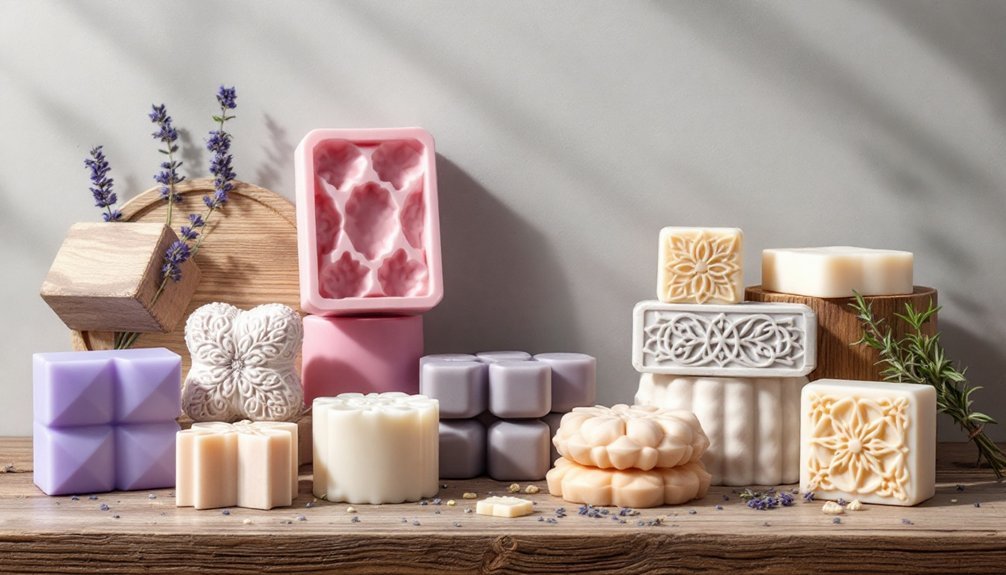



Leave a Reply